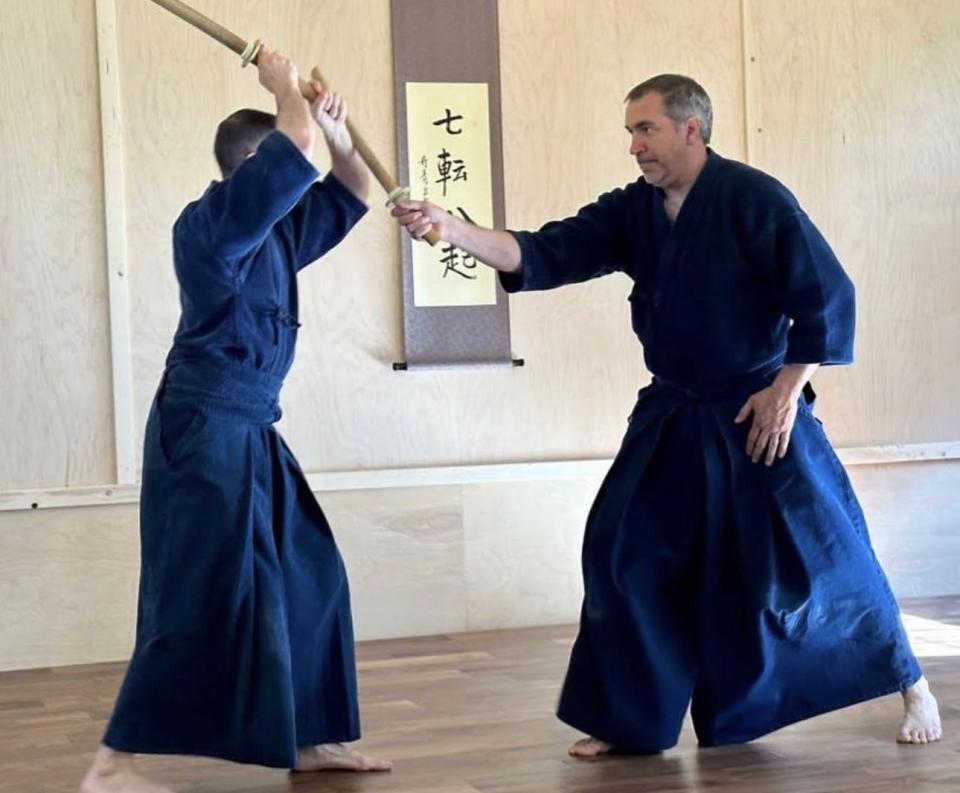What is Shinto Muso-ryu and how is a Templeton dojo part of a 400-year-old tradition?
A 400-year-old Japanese martial arts practice has made it to the Greater Gardener area thanks to Mike Caruso's passion.
Caruso has trained for over 17 years in the Japanese staff and sword practice, Shinto Muso-ryu. He said his interest in martial arts started when he was a teenager and he learned karate in Winchendon.
Three years ago, Caruso was authorized by his teachers to be able to teach the traditional Japanese practice. He said recently he has opened his own dojo in the backyard of his home in Templeton. Caruso teaches Shinto Muso-ryu classes every Sunday morning and he said classes are open to the public.

What is Shinto Muso-ryu?
Shinto Muso-ryu is only transferable by teacher to student. Caruso said this martial art cannot be taught through text or video, but only through a teacher and for four centuries the lineage has been unbroken.
A 4-foot staff is used during this martial arts practice. Caruso said students will become more observant because the practice focuses on being able to read your opponent's body language. The practice is done in pairs so students can foster their observation skills.
"The goal of this martial art is not really for self-defense but to learn the art," he said. "Shinto Muso-ryu promotes flexibility in the body and it does get you moving around but it's not like karate or jujitsu, you can do it well into your 80s."
Caruso said Shinto Muso-ryu training focuses on the technical aspects of the moves rather than being able to do self-defense. He said someone who knows the practice well can defend themselves using any object similar to the 4-foot staff used in the dojo. The objective is to make your opponent drop their weapon out of their hands, he said, not to kill them.
Shinto Muso-ryu nearly became a dying art after the United States dropped atomic bombs on the cities of Hiroshima and Nagasaki in Japan to end World War II. Caruso said after the bombing several martial arts schools that taught Shinto Muso-ryu disappeared and it caused decades of struggle to preserve the unbroken lineage of the martial art.
How Shinto Muso-ryu came to the United States
In 1970, Shinto Muso-ryu was brought into the U.S by martial arts educators in attempt to preserve the Japanese tradition, Caruso said.
What makes Shinto Muso-ryu different from other martial arts is that there is no modernized interpretation of the practice. Caruso said the centuries-old martial arts does not have a reward system like modern Karate does.
"In Shinto Muso-ryu, the student can obtain three scrolls from their teacher after many years of practice," he said. "The key to this martial art is to commit to the practice and keep going."
For the past 17 years, Caruso has done training once a month in New Jersey with teacher Diane and her husband Meik Skoss. The couple studied Shinto Muso-ryu while living in Japan for 37 years before moving to New Jersey and opening their own dojo.
Caruso said his teachers and their teachers are part of the four centuries-old unbroken transmission of the art. He said his small dojo is the only one that teaches Shinto Muso-ryu in the New England region.
The goal for his small dojo is to keep the practice of the martial art going so it doesn't die out, but not necessarily to gain students rapidly.
"My dojo is a branch in the tree, branches are going to die, and they are going to grow," he said. "The goal is to keep the tradition going, quality over quantity."
So far he has four students in his small dojo in his backyard. The only requirement is students must be at least 14 years old to practice Shinto Muso-ryu. Caruso said he doesn't charge his students but he does encourage a $20 donation pre-class so he can keep up his training and teaching of the practice.
Anyone interested in joining Caruso's classes can reach him through his dojo's Facebook page at Shinto Muso-ryu Templeton.
This article originally appeared on Gardner News: Ancient martial art taught in Templeton by Mike Caruso: Shinto Muso-ryu

